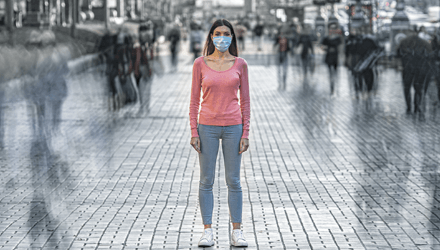By Sophie Neaves on Fri 10 March 2023 in Blog
Covid-19 & Ventilation: What did the pandemic teach us about the importance of IAQ?

When the Covid-19 virus hit in late 2019, nobody had any idea just how monumental its impact would be. Within months, the pandemic had made us rethink fundamental human behaviours and everyday practices. It also placed science firmly in the spotlight, with people looking to leading scientists to protect them and their families.
Since the virus is airborne, there was more focus than ever before on the very mechanics of respiration. Authorities quickly realised that people had to stay away from communal spaces to avoid transmitting Covid-19.
Moreover, properly ventilating those spaces became a priority and much greater emphasis was placed on the importance of indoor air quality (IAQ). Suddenly, IAQ became a matter of life and death.
How the COVID-19 pandemic taught us about the importance of IAQ
The Covid-19 pandemic has taught us a great deal about the importance of indoor air quality. While respiratory droplets are recognised as the primary mode of transmission for the virus, it’s now known that it can also spread through airborne particles known as aerosols. These particles can remain in the air long after an infected person has left a room – sometimes for hours – particularly if it’s an indoor room with poor ventilation.
Equipped with this knowledge of Covid-19 transmission methods, health officials’ attention soon turned to indoor air quality. But why is IAQ so important? Here are some ways the virus highlighted the issue of indoor air quality.
Transmission of Covid-19
Coughs, sneezes, breathing and talking are some of the main ways respiratory droplets containing the virus can spread. If another person inhales these droplets, they can become infected as well. This is why people were required to wear masks: to keep these droplets from spreading beyond the infected person.
However, in environments with poor air quality, the droplets can linger in the air and the risk of transmission goes up.
The role of ventilation
Naturally, changing the air in a room can remove viral particles from the area. Even over shorter periods of time, it can help to dilute them.
Insufficient ventilation, however, lets these particles build up in the air. People coming into contact with and breathing such air then have a higher chance of contracting viruses.
How filtration can help
HEPA air filters are present on most commercial aircraft, leading to some airlines claiming that flying presented less of a Covid-19 risk than most other activities.
IAQ is more important to vulnerable people
Some populations are affected much more by Covid-19 than others. For example, death rates among the elderly, immunosuppressed people and individuals with underlying health conditions are much higher.
As a result, maintaining a high level of indoor air quality became absolutely vital for these people when the pandemic hit. Those with existing respiratory or cardiovascular problems are particularly likely to suffer when faced with poor IAQ.
Measuring air quality
Air quality monitors can be indispensable, especially in older structures – such as schools, hospitals and other public buildings – that might lack sufficient ventilation. They measure levels of indoor pollutants, pinpointing places where the IAQ needs to be addressed. Needless to say, indoor air quality monitoring took on a new significance with the emergence of the pandemic.
What are the effects of poor indoor air quality?
Since Covid-19 was such an overwhelming, worldwide concern, the pandemic led to a much greater focus on the effects of low-quality indoor air. As a result, we now have an enhanced understanding of poor IAQ.
Acute effects
In medical terms, acute symptoms are ones that appear suddenly and usually disappear relatively quickly (in contrast to chronic conditions). The acute effects of poor IAQ can include:
- Dizziness and nausea – this is a particular risk if there are poisonous gases present
- Eye, nose and throat irritation – certain pollutants can cause coughing, sore throats, sneezing and/or a runny nose
- Headaches – another symptom than can result from chemical pollutants
- Skin irritation – rashes and irritation can come from exposure to some pollutants
Long-term effects
Over a longer period of time, the effects of substandard IAQ can be much more profound:
- Respiratory issues – conditions such as bronchitis, asthma and chronic obstructive pulmonary disease (COPD) can result in severe lung damage and breathing difficulties
- Cardiovascular disease – heart attacks, strokes and high blood pressure can all come from being exposed to indoor air pollutants
- Neurological conditions – substances such as mercury and lead can cause cognitive impairment, erratic behaviour and even developmental delays
- Cancer – being exposed to pollutants like radon and volatile organic compounds (VOCs) has been associated with cancer
Given the severity of conditions like these, improving indoor air quality should be a priority for every building owner.
How to maintain good indoor air quality?
Open windows to let in fresh air
The most basic way to improve indoor air quality is by opening windows. When schools first reopened following the pandemic, opening windows was a requirement. But how does air help reduce Covid-19 spread and improve air quality?
Although it can take some time, opening windows does change the air in a room. Eventually, it dilutes viral particles and removes them from the space, replacing them with fresh air.
Opening two windows enhances the effect of ventilation, creating a cross-draught. This brings fresh air through one window and allows stale air out through the other window.
Invest in an air purifier
An air purifier works by drawing polluted air in, passing it through filters (such as HEPA filters) and releasing it back into the room. By doing so, they can significantly reduce airborne virus loads inside a room. Advanced systems are capable of collecting almost 100% of harmful airborne particles.
Ensure temperature and humidity is at an optimum level
When people are looking at how to improve air quality in home environments, they’re increasingly turning to mechanical ventilation with heat recovery. MVHR constantly extracts stale, humid air and replaces it with clean air from outside. Unlike some ventilation systems though, MVHR takes heat from the outgoing humid air and uses it to heat the incoming fresh air.
Removing humidity from a room is vital because humid air is more hospitable to some pollutants – as well as mould. Low temperatures also make mould growth more likely. Fortunately, MVHR offers complete control over both humidity and temperature.
In summary
The Covid-19 pandemic has highlighted the importance of indoor air quality in controlling the spread of viruses and generally protecting human health. Proper ventilation, air filtration and air purification can all play a critical role in improving indoor air quality and reducing health risks.


